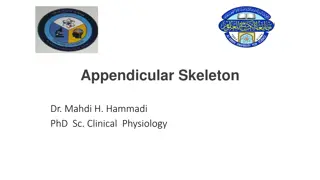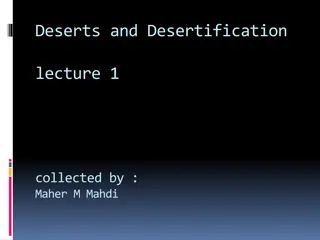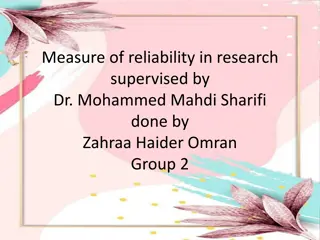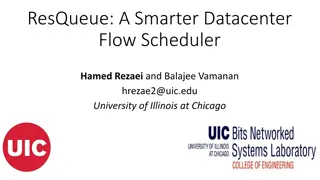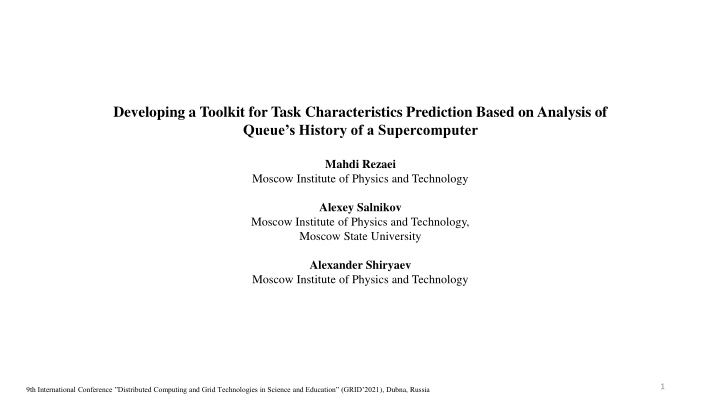
Task Characteristics Prediction Toolkit Based on Supercomputer Queue History
Developing a toolkit for predicting task characteristics in high-performance computing systems based on the analysis of queues' history on a supercomputer. The toolkit aims to improve resource management by predicting required resources accurately, addressing the issues of underestimation and overestimation of resource allocation. A supervised machine learning system is being built to enhance prediction accuracy, with a focus on regression and classification tasks. The approach involves extracting statistical data from reference queue systems and utilizing predictive analytics for user decision-making. The system includes a plugin for practical use of machine learning algorithms, showing that adding more features to the dataset enhances prediction accuracy.
Download Presentation

Please find below an Image/Link to download the presentation.
The content on the website is provided AS IS for your information and personal use only. It may not be sold, licensed, or shared on other websites without obtaining consent from the author. If you encounter any issues during the download, it is possible that the publisher has removed the file from their server.
You are allowed to download the files provided on this website for personal or commercial use, subject to the condition that they are used lawfully. All files are the property of their respective owners.
The content on the website is provided AS IS for your information and personal use only. It may not be sold, licensed, or shared on other websites without obtaining consent from the author.
E N D
Presentation Transcript
Developing a Toolkit for Task Characteristics Prediction Based on Analysis of Queue s History of a Supercomputer Mahdi Rezaei Moscow Institute of Physics and Technology Alexey Salnikov Moscow Institute of Physics and Technology, Moscow State University Alexander Shiryaev Moscow Institute of Physics and Technology 1 9th International Conference Distributed Computing and Grid Technologies in Science and Education (GRID 2021), Dubna, Russia
Developing a Toolkit for Task Characteristics Prediction Based on Analysis of Queues History of a Supercomputer Prediction in HPC systems: Resource management in High Performance Computing (HPC). SLURM as a job schedulers to manage workload on HPC systems. Major drawback of SLURM. 2 9th International Conference Distributed Computing and Grid Technologies in Science and Education (GRID 2021), Dubna, Russia
Developing a Toolkit for Task Characteristics Prediction Based on Analysis of Queues History of a Supercomputer Features of the task flow User s resource estimation lacks accuracy. Underestimation and Overestimation of resource allocation. Therefore, we need to construct a software which can predict the required resources based on historical data. 3 9th International Conference Distributed Computing and Grid Technologies in Science and Education (GRID 2021), Dubna, Russia
Developing a Toolkit for Task Characteristics Prediction Based on Analysis of Queues History of a Supercomputer Our approach A supervised machine learning (ML) system is being built based on the collection of statistical data from reference queue systems. Predictive analytics tasks, that means regression and classification. A plugin in practical applications used by the system user was studied. Results indicated that: adding more features to the dataset improves the prediction accuracy. the plugin allows practical use of the proposed machine learning algorithms for user decision making. 4 9th International Conference Distributed Computing and Grid Technologies in Science and Education (GRID 2021), Dubna, Russia
Developing a Toolkit for Task Characteristics Prediction Based on Analysis of Queues History of a Supercomputer Block diagram of our proposed system 5 9th International Conference Distributed Computing and Grid Technologies in Science and Education (GRID 2021), Dubna, Russia
Developing a Toolkit for Task Characteristics Prediction Based on Analysis of Queues History of a Supercomputer Machine Learning 6 9th International Conference Distributed Computing and Grid Technologies in Science and Education (GRID 2021), Dubna, Russia
Developing a Toolkit for Task Characteristics Prediction Based on Analysis of Queues History of a Supercomputer Predictive analytics Predictive analytics is the use of statistical data, and machine learning techniques to identify the likelihood of future outcomes based on historical data. There are two types of predictive models: I. Classification model II. Regression model 7 9th International Conference Distributed Computing and Grid Technologies in Science and Education (GRID 2021), Dubna, Russia
Developing a Toolkit for Task Characteristics Prediction Based on Analysis of Queues History of a Supercomputer Regression vs Classification Classification algorithms are used when the output is a discrete label. Regression is useful for predicting continuous outputs. In this project we use regression algorithms to predict the amount of required resources (CPUs and time slots) and classification algorithms to check failure of jobs due to resource underestimation. 8 9th International Conference Distributed Computing and Grid Technologies in Science and Education (GRID 2021), Dubna, Russia
Developing a Toolkit for Task Characteristics Prediction Based on Analysis of Queues History of a Supercomputer Construction features and custom modelling for our ML We used the Python programming language. We used TensorFlow. We used scikit-learn libraries. 9 9th International Conference Distributed Computing and Grid Technologies in Science and Education (GRID 2021), Dubna, Russia
Developing a Toolkit for Task Characteristics Prediction Based on Analysis of Queues History of a Supercomputer Algorithms used for regression MLP: Multilayer Perceptron RFR: Random Forest Regression LR: Lasso Regression KNN: K-Nearest Neighbor Regression OLSR: Ordinary least-squares regression: SVR: Support Vector Regression RR: Ridge Regression PR: Polynomial Regression CARTR: CART (Classification and Regression Trees) Regression Algorithms used for classification Naive Bayes classifier Kernel Support Vector Machines (SVM) CART classification 10 9th International Conference Distributed Computing and Grid Technologies in Science and Education (GRID 2021), Dubna, Russia
Developing a Toolkit for Task Characteristics Prediction Based on Analysis of Queues History of a Supercomputer Plugin 11 9th International Conference Distributed Computing and Grid Technologies in Science and Education (GRID 2021), Dubna, Russia
Developing a Toolkit for Task Characteristics Prediction Based on Analysis of Queues History of a Supercomputer Why plugin? To implement our system on real clusters we designed a plugin. Our plugin is dynamically connected SPANK plugin and while executing srun and sbatch commands, takes control on them. The plugin by default is connected to Slurm plugstack.conf configuration file. 12 9th International Conference Distributed Computing and Grid Technologies in Science and Education (GRID 2021), Dubna, Russia
Developing a Toolkit for Task Characteristics Prediction Based on Analysis of Queues History of a Supercomputer Types of plugins Static. Connected by adding plugin s source code in a special way into the SLURM source code and somehow rebuilding the SLURM. Dynamic. Connected to the SLURM through a special interface SPANK (without access to the SLURM source code). This type, requires adding parameters to the plugstack.conf configuration file. 13 9th International Conference Distributed Computing and Grid Technologies in Science and Education (GRID 2021), Dubna, Russia
Developing a Toolkit for Task Characteristics Prediction Based on Analysis of Queues History of a Supercomputer Experiments 14 9th International Conference Distributed Computing and Grid Technologies in Science and Education (GRID 2021), Dubna, Russia
Developing a Toolkit for Task Characteristics Prediction Based on Analysis of Queues History of a Supercomputer Data preparation Collected statistics of Bluegene/P system installed at the Faculty of Computational Mathematics and Cybernetics, Lomonosov Moscow State University named after M.V Lomonosov. This statistic includes information of jobs which have been run during almost 12 months in 2017. To train our ML, two sets of features are used: per_job features and per_user features. 15 9th International Conference Distributed Computing and Grid Technologies in Science and Education (GRID 2021), Dubna, Russia
Developing a Toolkit for Task Characteristics Prediction Based on Analysis of Queues History of a Supercomputer per_job features Feature time_limit num_cpus id name user group task_class state required_time Description time requested by the user for the job the number of processors requested for the job task id as defined in the job scheduling system user-specified task name Username user group task class the status of a job that has been completed or deleted the time during which the task is executed. This time will be predicted for newly submitted jobs. the number of processors used by the job at runtime. This number will be predicted for newly submitted jobs. required_cpu 16 9th International Conference Distributed Computing and Grid Technologies in Science and Education (GRID 2021), Dubna, Russia
Developing a Toolkit for Task Characteristics Prediction Based on Analysis of Queues History of a Supercomputer per_user features Feature used_portion_of_time_limit avg_aborted_task average_congestion average_cpus duration wait_time / time_limit average_time_limit Description the reasonableness of the runtime requested by the user percentage of interrupted tasks submitted by the user average system load by user average number of CPUs requested average waiting time in queue Average ratio of time in queue to requested time Average time set by user 17 9th International Conference Distributed Computing and Grid Technologies in Science and Education (GRID 2021), Dubna, Russia
Developing a Toolkit for Task Characteristics Prediction Based on Analysis of Queues History of a Supercomputer Plugin design Our plugin is called as MLSP (Machine Learning Slurm Plugin). This application is divided into 2 subsystems: fit-subsystem which trains models and predict-subsystem which predicts the start time of the submitted job using present models. The language to develop our plugin is C programming. 18 9th International Conference Distributed Computing and Grid Technologies in Science and Education (GRID 2021), Dubna, Russia
Developing a Toolkit for Task Characteristics Prediction Based on Analysis of Queues History of a Supercomputer Solution methods Several options for solving this problem were considered: modify the Slurm source code, write a "fat" plugin for Slurm that would run including user code, write a "thin" plugin for Slurm, and do the main work in a separate demon Linux, written on comfortable language programming. 19 9th International Conference Distributed Computing and Grid Technologies in Science and Education (GRID 2021), Dubna, Russia
Developing a Toolkit for Task Characteristics Prediction Based on Analysis of Queues History of a Supercomputer Alternative method Writing a thin plugin avoids rebuilding Slurm while changes occur. Rebuilding Slurm is pretty useless In addition, during development, you will have to write more C code. Writing the thin plugin will also allows us to decouple the work of training the model from the launch Slurm. But for a separate application you need your own scripts /configuration files to run. 20 9th International Conference Distributed Computing and Grid Technologies in Science and Education (GRID 2021), Dubna, Russia
Developing a Toolkit for Task Characteristics Prediction Based on Analysis of Queues History of a Supercomputer Alternative method A dynamically connected SPANK plugin, which will add the option --predict-time and take control on executing the srun and sbatch commands. The plugin is connected by default in the Slurm plugstack.conf configuration file. There you can also set arguments for the plugin. The plugin must be developed in the language C programming. 21 9th International Conference Distributed Computing and Grid Technologies in Science and Education (GRID 2021), Dubna, Russia
Developing a Toolkit for Task Characteristics Prediction Based on Analysis of Queues History of a Supercomputer Component development Main application Spank plugin 22 9th International Conference Distributed Computing and Grid Technologies in Science and Education (GRID 2021), Dubna, Russia
Developing a Toolkit for Task Characteristics Prediction Based on Analysis of Queues History of a Supercomputer Main application The application in this case was called MLPD (Machine Learning Python Daemon). The main file of the mlpd.py application contains the function mlpd (), which implements the application. The main application must support training the model and responding to HTTP requests and is a Linux daemon. Thus, the application can be divided into 2 subsystems: model training (fit subsystem) and predictions time by the current model (predict subsystem). 23 9th International Conference Distributed Computing and Grid Technologies in Science and Education (GRID 2021), Dubna, Russia
Developing a Toolkit for Task Characteristics Prediction Based on Analysis of Queues History of a Supercomputer SPANK plugin The plugin in this case was named MLSP (Machine Learning Slurm Plugin). The main SPANK plugin file is a dynamic librarymlsp.so whose source file is mlsp.c. The code is divided into 2 large parts: main - for working with Slurm. auxiliary for work with the server. 24 9th International Conference Distributed Computing and Grid Technologies in Science and Education (GRID 2021), Dubna, Russia
Developing a Toolkit for Task Characteristics Prediction Based on Analysis of Queues History of a Supercomputer Working with Slurm and SPANK The system must be told that user is using SPANK. Furthermore, it is necessary to register the --predict-time option before processing. 25 9th International Conference Distributed Computing and Grid Technologies in Science and Education (GRID 2021), Dubna, Russia
Developing a Toolkit for Task Characteristics Prediction Based on Analysis of Queues History of a Supercomputer Working with the server The predicttime() function accepts the argc and argv[] as startup arguments and should do the following steps: Prepare and execute an HTTP request. Show the answer. 26 9th International Conference Distributed Computing and Grid Technologies in Science and Education (GRID 2021), Dubna, Russia
Developing a Toolkit for Task Characteristics Prediction Based on Analysis of Queues History of a Supercomputer Evaluation 27 9th International Conference Distributed Computing and Grid Technologies in Science and Education (GRID 2021), Dubna, Russia
Developing a Toolkit for Task Characteristics Prediction Based on Analysis of Queues History of a Supercomputer Regression Regression with per-job features. per-user features added to the dataset. R-squared statistic, a common measure of accuracy, and MSE (Mean Squared Error) were used to evaluate our regression model. Changes in the value of these criteria are compared. 28 9th International Conference Distributed Computing and Grid Technologies in Science and Education (GRID 2021), Dubna, Russia
Developing a Toolkit for Task Characteristics Prediction Based on Analysis of Queues History of a Supercomputer Table 1. Regression with per_job features Required number of CPU MSE Required time MSE Model R2 R2 MLP 0.18 0.29 0.37 0.47 RFR 0.99 0.56 0.01 0.31 LR 0.21 0.17 0.45 0.36 KNN 0.06 0.77 0.40 0.43 OLSR 0.17 0.21 0.45 0.37 SVR 0.11 0.20 0.22 0.13 RR 0.17 0.21 0.45 0.37 PR 0.19 0.21 0.40 0.44 CARTR 0.96 0.01 0.37 0.48 29 9th International Conference Distributed Computing and Grid Technologies in Science and Education (GRID 2021), Dubna, Russia
Developing a Toolkit for Task Characteristics Prediction Based on Analysis of Queues History of a Supercomputer Table 2. Regression with added per_user features Required number of CPU MSE Required time MSE Model R2 R2 MLP 0.72 0.54 0.07 0.33 RFR 0.98 0.02 0.3 0.57 LR 0.20 0.22 0.45 0.37 KNN 0.06 0.75 0.36 0.49 OLSR 0.20 0.22 0.44 0.37 SVR 0.37 0.21 0.17 0.15 RR 0.20 0.22 0.37 0.44 PR 0.61 0.10 0.34 0.51 CARTR 0.96 0.01 0.34 0.53 30 9th International Conference Distributed Computing and Grid Technologies in Science and Education (GRID 2021), Dubna, Russia
Developing a Toolkit for Task Characteristics Prediction Based on Analysis of Queues History of a Supercomputer Classification Tasks that will be removed from execution Tasks that will complete successfully. Classifiers were used: We used the F1 statistic score (F1-score) Changes in the value of this criterion are compared. 31 9th International Conference Distributed Computing and Grid Technologies in Science and Education (GRID 2021), Dubna, Russia
Developing a Toolkit for Task Characteristics Prediction Based on Analysis of Queues History of a Supercomputer Classification using per_job features Naive Bayes classifier Kernel Support Vector Machines CART classification Precision Recall F1-score Precision Recall F1-score Precision F1-score Recall Job completed 0.89 0.88 0.90 0.89 0.88 0.88 0.87 0.87 0.89 Job removed 0.16 0.14 0.14 0.15 0.16 0.10 0.11 0.10 0.13 Baseline accuracy 79.2 % 78 % 80.64 % 32 9th International Conference Distributed Computing and Grid Technologies in Science and Education (GRID 2021), Dubna, Russia
Developing a Toolkit for Task Characteristics Prediction Based on Analysis of Queues History of a Supercomputer Classification using per_user features Naive Bayes classifier Kernel Support Vector Machines CART classification Precision Recall F1-score Precision Recall F1-score Precision F1-score Recall Job completed 0.88 0.87 0.87 0.89 0.88 0.89 0.90 0.90 0.90 Job removed 0.11 0.13 0.12 0.15 0.16 0.15 0.14 0.14 0.14 Baseline accuracy 77.92 % 79.76 % 81.44 % 33 9th International Conference Distributed Computing and Grid Technologies in Science and Education (GRID 2021), Dubna, Russia
Developing a Toolkit for Task Characteristics Prediction Based on Analysis of Queues History of a Supercomputer Precision and Recall What proportion of positive identifications were actually correct? What proportion of actual positives have been identified correctly? 34 9th International Conference Distributed Computing and Grid Technologies in Science and Education (GRID 2021), Dubna, Russia
Developing a Toolkit for Task Characteristics Prediction Based on Analysis of Queues History of a Supercomputer F1 might be the best measure to use when we need to find a balance between Precision and Recall and there is an uneven distribution of classes. 35 9th International Conference Distributed Computing and Grid Technologies in Science and Education (GRID 2021), Dubna, Russia
Developing a Toolkit for Task Characteristics Prediction Based on Analysis of Queues History of a Supercomputer (a) R2 values in the regression problem to predict the number of required CPUs (b) R2 values in the regression problem to predict the required time (c) F1-score of the classification value. 36 9th International Conference Distributed Computing and Grid Technologies in Science and Education (GRID 2021), Dubna, Russia
Developing a Toolkit for Task Characteristics Prediction Based on Analysis of Queues History of a Supercomputer Conclusions and future work The accuracy of the prediction is related to the number and type of features. Adding computed per-user features to the dataset improved prediction accuracy. The possibility of writing a plugin to apply our machine learning system in practical applications was studied. It was found that the plugin allows practical use of the machine learning algorithms in decision making. It is planned to use this component to evaluate our algorithms on a real cluster to find the best method to predict the resources. Moreover, we need to increase the number of supported libraries (not only Tensorflow) to save the model to a file. Furthermore, we need to make a plugin that looks for all environment variables to obtain the best predictions. The data retrieved from the database to be used on the servers where security is in high priority, should be anonymized. 37 9th International Conference Distributed Computing and Grid Technologies in Science and Education (GRID 2021), Dubna, Russia
Thank you 38
Developing a Toolkit for Task Characteristics Prediction Based on Analysis of Queues History of a Supercomputer 39 9th International Conference Distributed Computing and Grid Technologies in Science and Education (GRID 2021), Dubna, Russia


